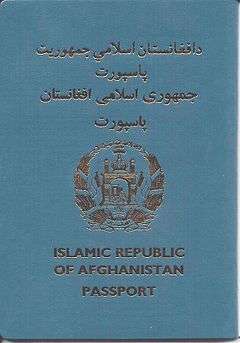Afghan passport
The Afghan passport is issued to citizens of Afghanistan for international travel. It is renewable every 5-10 years. As of 2019, nearly one million computerized Afghan passports have been issued.[1] The Afghan passport was introduced by Emir Abdur Rahman Khan in 1880.
| Afghan passport | |
|---|---|
 Front cover of a contemporary Afghan biometric passport. | |
| Type | Passport |
| Issued by | |
| First issued | 1880 |
| Purpose | Identification |
| Eligibility | Afghan citizenship |
| Expiration | 5-10 years |
| Cost | $75- 145$ |
In September 2011, the Afghan Ministry of Foreign Affairs began issuing two types of biometric passports (e-passports) for Afghan diplomats and public servants. These were produced in the United Kingdom.[2][3] In March 2013, new international standard e-passports were introduced to all citizens of Afghanistan.[4] According to spokesman of the Ministry of Foreign Affairs, Janan Musazai, "on the photo page, there are 16 security codes."[2] Issuance of national computerized e-ID cards (e-Tazkiras) were also discussed.[5] These changes are expected to prevent fraud in future elections, government corruption and improve the security situation of Afghanistan. In 2013, the cost of a new Afghan e-passport was 5,000 Afghanis ($100 US dollars),[6] but in 2019 it was 10,000 afghanis (circa £99).[7] Previously, passports had been hand written; they are no longer valid. [8]
Afghanistan currently has only one passport office, which is located in Kabul.[9] Ordinary passports (those other than diplomatic or service passports) can be issued by Afghan embassies and consulates abroad.[10]
As of 24 April 2020, Afghan citizens had visa-free or visa on arrival access to only 26 countries and territories, ranking the Afghan passport joint 104th in the world (worst along with the Iraqi passport) according to the Henley Passport Index.[11]
References
- Afghanistan Launches Online Passport Application Service
- Meer Agha Nasrat Samimi, ed. (September 17, 2011). "Foreign ministry issues computerised passports". Pajhwok Afghan News (PAN). Retrieved 2012-12-30.
- Ataullah Khpelwak, ed. (September 18, 2011). "Foreign ministry issues computerised passports (Video)". Pajhwok Afghan News. Archived from the original on March 6, 2014. Retrieved 2011-10-18.
- Ahmad Quraishi, ed. (March 24, 2013). "Machine-readable passport system put in place". Pajhwok Afghan News. Retrieved 2013-03-31.
- Ghulam Hussain Zakiri, ed. (February 24, 2013). "14m Afghans to get computerised ID cards in a year". Pajhwok Afghan News. Retrieved 2013-03-31.
- Azizullah Hamdard, ed. (March 5, 2013). "Countrywide electronic passports soon". Pajhwok Afghan News. Retrieved 2014-03-05.
- Glinski, Stefanie (2019-06-12). "Patients sleep under the stars in long queue for medical visas | Stefanie Glinski". The Guardian. ISSN 0261-3077. Retrieved 2019-06-14.
- https://www.econsulate.gov.af/en/passport.html
- Norland, Rob (19 Sep 2015). "Abandoning Afghan War Zone in a Perilous Quest for Europe". The New York Times. Retrieved 19 Sep 2015.
- "Passport Information". afghanemb-canada.net. Embassy of Afghanistan in Ottawa. Retrieved November 7, 2016.
- "The Henley Passport Index" (PDF). Henley & Partners Holdings Ltd. 8 January 2019. Retrieved 8 January 2019.
This graph shows the full Global Ranking of the 2019 Henley Passport Index. As the index uses dense ranking, in certain cases, a rank is shared by multiple countries because these countries all have the same level of visa-free or visa-on-arrival access.
External links
- Afghanistan Launches Online Passport Application Service
- Afghanistan: Passport Law of 25 October 2015; appearance and security features of passports; specimen of passports (2015-January 2018)
- Sample of current Afghan passport